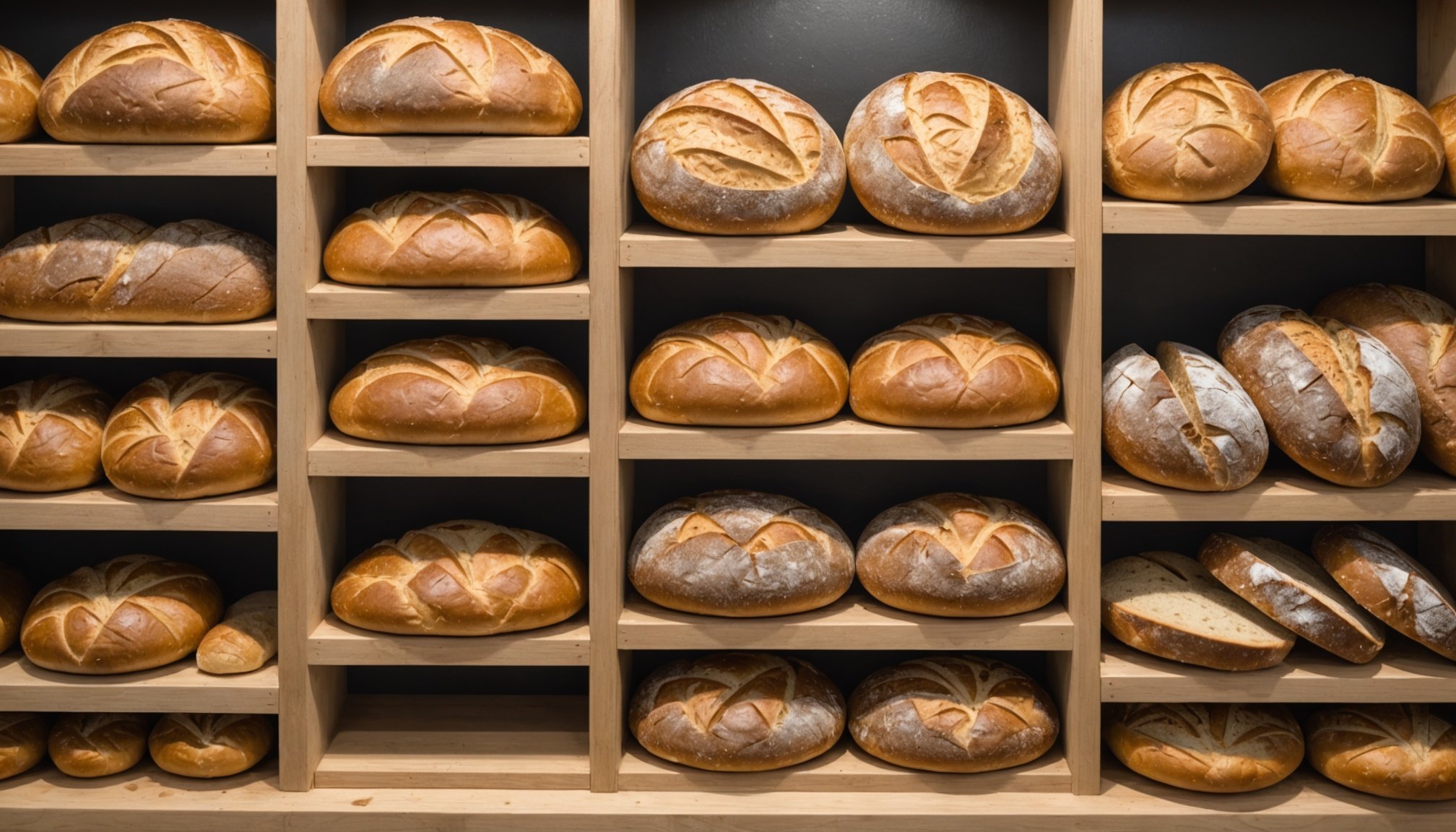Understanding the Importance of Custom Storage for Artisanal Bread
Preserving the freshness of artisanal bread is crucial for maintaining its rich flavour and texture. Custom storage solutions play a significant role in ensuring that bread retains its quality over time. Without the right storage, bread can quickly become stale, losing its signature traits that bakers and consumers alike cherish.
When it comes to artisanal bread preservation, attention to detail is key. Custom storage solutions help manage the delicate balance of humidity and airflow, which is vital to prevent the bread from drying out or getting too moist. Furthermore, ensuring that there is adequate ventilation without exposing the bread to excessive air is a fine art that can significantly impact bread quality.
Have you seen this : Create a Serene Zen Oasis in Your Guest Room: The Ultimate Guide to Mindfulness and Relaxation
Home bakers often encounter common storage challenges. These may include finding the right balance between temperature and moisture, especially in variable climates. Artisanal bread, unlike commercial bread, lacks preservatives, making it more susceptible to environmental conditions. Effective baking organization and storage methods help extend the freshness and shelf life of these unique loaves.
In summary, the necessity of proper storage cannot be overstated for anyone serious about maintaining the quality of artisanal bread. Tailoring storage solutions not only helps retain fresh flavour but also supports the intricate texture characteristics unique to handcrafted loaves.
Also to see : Designing an Elegant and Functional Garden Water Recycling System: The Ultimate Step-by-Step Guide
Materials Needed for Custom Storage Solutions
Exploring the essentials of storage materials can transform your approach to bread preservation. Crafting the perfect environment for your artisanal loaves starts with selecting the right materials. For instance, wood, known for its balance of moisture and airflow control, makes a smart choice for constructing bread storage units. Meanwhile, metal and glass can offer an aesthetic appeal but need clever design to ensure proper ventilation.
When deciding on bread box options, consider the style of bread you most frequently bake. For denser or larger loaves like sourdough, opt for a spacious box that allows air circulation. In contrast, a smaller, tighter box suits lighter breads such as baguettes or ciabattas.
For those on a budget, DIY bread storage methods present feasible solutions. Try using breathable cloth bags or repurposed wooden crates as effective storage styles, ensuring they have a clean, dry interior. You can also experiment with combining different materials to see which mix best supports your baking routine. Whether you’re constructing from scratch or customising current containers, the right materials make all the difference between stale and scrumptious.
Step-by-Step Guide to Designing Your Storage Solution
Designing a custom bread box is a rewarding process that enhances your baking organisation. Start by planning your design—measure the available space and consider the types of bread you bake most frequently. This helps tailor your storage solution to your specific needs, whether you’re dealing with wide sourdough loaves or slim baguettes.
Planning Your Design
Before construction, identify key factors such as ventilation needs, moisture control, and the dimensions of your storage space. Understanding these elements ensures your design effectively preserves artisanal bread freshness and flavour.
Choosing Functional Features
When designing storage, focus on features like ventilation and moisture control. Bread requires a balance of humidity and airflow that prevents staleness or mould. Features should ensure ease of accessibility as well—consider how easily you can reach your loaves without disturbing their storage environment.
Construction Process
For the construction process, select sturdy materials that suit your home’s aesthetic. Equip yourself with essential tools like saws or sanders, and utilise techniques that guarantee durability. Often, these decisions define whether your custom storage remains effective and elegant over time. Incorporate tools and strategies that will enhance both the practicality and longevity of your custom bread box.
Preserving Bread Freshness
Maintaining the freshness of homemade bread requires adept storage techniques. One effective approach involves controlling both humidity and temperature. Bread stores well in a cool, dry environment, away from direct sunlight and excessive heat. This minimises moisture loss and helps in retaining the bread’s unique flavour and texture.
Techniques for Freshness
One popular method is to wrap the bread in a breathable cloth, which prevents it from drying out while allowing for some airflow. For additional protection, place the cloth-covered loaf in a loosely sealed container, avoiding airtight seals that can lead to mould growth. This technique combines storage techniques for optimal results.
Humidity and Temperature Control
Humidity plays a critical role, with too much moisture risking mould, while too little can result in staleness. Use suggested liners such as wax paper or parchment inside your storage container to manage moisture levels effectively. Temperature should remain consistent to further enhance the bread’s freshness.
Enhancing Freshness with Materials
Opt for materials like wood or ceramic, known for their ability to balance moisture. Their natural properties support sustainable storage techniques and help maintain bread integrity longer. Integrating these methods ensures your homemade bread retains its delightful qualities for as long as possible.
Design Options for Aesthetics and Functionality
Creating the perfect bread storage aesthetics means balancing functionality and style. This not only enhances the overall look of your kitchen but also improves ease of access and bread preservation. By choosing storage options that complement your existing decor, the storage unit becomes a feature rather than a hidden accessory.
Matching Storage Design with Kitchen Decor
Envision a functional storage solution that mirrors your kitchen’s theme. If you have a rustic setting, a wooden bread box with natural finishes aligns beautifully. For modern kitchens, a minimalist design in glass or polished metal adds sleek sophistication.
Innovative Ideas for Custom Storage
Incorporating innovative ideas can transform your bread storage into a dual-purpose item. Think of units that include display shelves for spices or hooks for kitchen towels. These added elements enhance your kitchen’s practicality without compromising the aesthetic design.
Balancing Functionality with Style
Focus on designs that effectively balance both elements. Prioritise bread storage that maintains freshness—such as options with adjustable ventilation—and complements your kitchen’s style. Always choose materials and designs that offer durability alongside appeal, ensuring your custom storage serves both as an efficient solution and a visual delight.
Troubleshooting Common Storage Problems
Understanding storage challenges is crucial to preserving your artisanal bread. Identifying common problems like staleness and mould quickly allows for targeted bread storage troubleshooting.
Identifying Signs of Improper Storage
Crust that hardens too quickly or crumbly interiors often indicate improper storage. Mould growth, especially in humid environments, is another frequent issue. Noticing these signs early can save your bread from becoming unsalvageable.
Adaptation Strategies for Different Climates
Climate plays a role in storage effectiveness. In humid areas, an airtight container might trap unwanted moisture, while too much dryness in arid regions can speed up staleness. Solutions for storage issues may include humidity-control packs or investing in a bread storage unit that balances moisture effectively.
Addressing Mould and Staleness Effectively
Combat mould by ensuring all storage materials are clean and dry before use. For recurrent staleness, choose storage environments that maintain consistent temperatures. Implementing a thoughtful mix of materials and techniques helps address these challenges and keeps bread fresh for longer periods.
By identifying the root causes and employing adaptive strategies, you can effectively troubleshoot and improve your bread storage methods.
Customization Ideas for Different Bread Types
Tailoring your storage solution to accommodate various bread types is crucial for maintaining their unique qualities. Each type of bread, from sourdough to baguettes, demands specific storage considerations to ensure longevity and freshness.
Specific Storage Needs for Sourdough vs. Baguettes
Sourdough bread thrives in a setting that balances moisture to prevent its hearty crust from getting tough. Consider containers with adjustable ventilation to maintain the ideal humidity level. Baguettes, with their elongated shape and airy texture, require storage solutions that protect their delicate nature. Opt for longer, narrow storage units that avoid compression and allow for airflow.
Incorporating Additional Features Based on Bread Diversity
Adapting storage with custom features can significantly enhance bread preservation. For instance, adding a removable rack in storage boxes can accommodate different bread sizes and types, increasing the versatility of your custom storage.
Personalised Tips from Experienced Bakers on Storage Customization
Experienced bakers often suggest utilising lined baskets for storing artisan breads, which help retain distinct textures while allowing for airflow. Additionally, incorporating humble cloth wrappings can offer traditional yet effective preservation techniques, ensuring bread remains fresh and delectable over time. These strategies are backed by generations of baking expertise, providing a tested approach to artisanal bread care.





